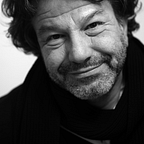Circular aesthetics (draft)
What are circular aesthetics? We all have heard of circular economies: They are about the elimination of the concept of waste. Circularity means to renew, repair and regenerate resources as opposed to a model of linear production often referred to as: ‘take, make, dispose’.
How would this work with aesthetics, commonly understood as our perception and appreciation of beauty?
First, we need to do away with the prejudice that beauty is to be found in the eye of the beholder. Apparently, the traces of preference and appreciation by what was formerly known as the beholder have turned into the most valuable resource of a so-called platform economy. But circular aesthetics are not primarily concerned with administering the big data that stem from whims, taste, liking or arbitrary judgement.
Secondly, we have to abandon the myth of the artist as the sole creator extracting meaning from material and dumping it as sense to consumers, predominantly in some form of illustration, embellishment, decoration or entertainment.
A circular approach to aesthetics needs to question the role to which the consumer is condemned as well as the role of the creator. In a circular perspective, it becomes evident how both roles condition, attract and comfort each other — mirror reflections that endlessly repeat themselves, divide and define modalities, distract and consume attention.
Circular aesthetics are attended by a different way of looking at art and artifacts. The latter cannot be seen only within the limits of their own life cycle. They have to be perceived in a constant movement and transmission while including and interacting with other forms of social and societal innovation. In circular aesthetics, there is no continuity that would not consist of constant change while every change insists on a certain continuity.
Circular aesthetics of a first order apply the idea of circularity to the material or immaterial objects of artistic production: re-using the leftovers of a Biennale exhibition in new artistic projects; building musical instruments from fully degradable bioplastics or skyscrapers as “vertical forests”; up-cycling the attention that is characteristic for an art venue and refining it into social or political commitment.
Aesthetics become circular as soon as they do not only raise awareness but stimulate transformations: evoking curiosity, modulating distance, empowering collaborators and encouraging cycles of a creativity that can sustain itself — rather than extracting value in an assembly line that incessantly exploits emotions and empathy to customize immersion and provide identification.
On the contrary, the challenge is to synthesize sensory experiences and translate them into coherent models of agency which then form the immaterial basis for co-creation and collective creativity. It resembles a spiral running, time and again, through the four fields of sensing, synthesizing, acting, multiplying.
Circular aesthetics revolve around signs and sensations that push us out of the comfort zone of habitual perception. They disrupt the ordinary and call the familiar into question by involving and including artists, audiences, artworks — equally and in an escalating fashion.
This leads to a second order of circular aesthetics in which the very idea of circularity is constitutive for aesthetics as such — with the aim to re-appropriate abstract meaning or the meaning of abstraction. The result is not only a recursive reduction of clutter such as sentiment, ornament or connoisseurship; by realigning quality, impact and value, second order circular aesthetics build and regenerate epistemologies of non-linear thinking and acting that is so urgent today.
On this basis, a first, preliminary hypothesis can be raised and must be proven:
A work which claims to have sustainable societal impact must necessarily advance in all its qualities and dimensions — technical, aesthetic, social etc. Rather than showing good intentions, it needs to question and undo expectations. Rather than exceeding them, it puts new relationships between knowledges to the test.
These relationships are neither limited, functional nor one-directional, but there is no way back home. Since the baselines of what is considered natural or pristine constantly shift, it makes no sense to long for a return to a cliche of peace and harmony with so-called ‘nature’.
All that is human made can still be changed by humans. But this would require a third order of circular aesthetics which demands radically new ways of working together that would be capable of dealing with the consequences of the disruptions to come, in a society after the spectacle.
Some guiding principles of circular aesthetics:
- Responsible use of attention: Up-cycling attention as a valuable, but limited resource and refining it into commitment
- Way beyond participation: Empowering audiences as co-creators and understanding authorship as a renewable resource
- Open beauty as collective ownership of artistic value: Re-appropriating impact and its attribution
- Reversibility rather than feedback: Drawing from imperfection, failure and mistake as the source code of collective intelligence
- Continuity and change: Constantly questioning sustainability in dynamic, immanent and integrated perspectives to make visible differences that would otherwise remain invisible
- Divisions of creative labor: Compiling new roles resulting from the tensions that emerge between planning and improvisation, anticipation and participation
- Production of space that is neither private nor public: Encrypting interactions to regain control over the exploitation of meta- and preference data.
